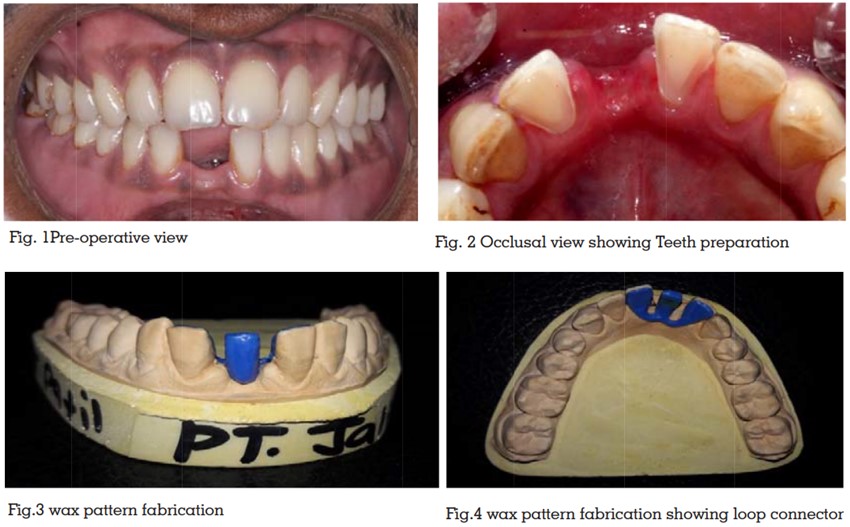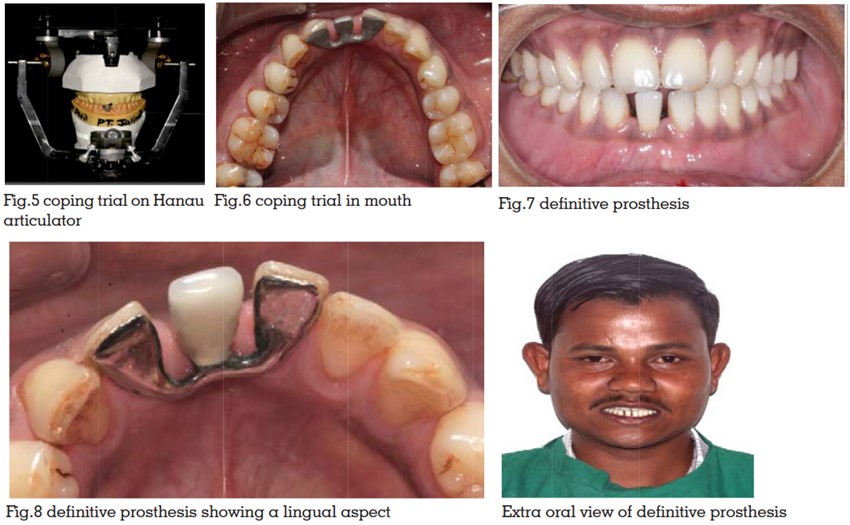

Restoring a single missing tooth in the mandibular anterior region is often a great concern to the dentist because it requires unnecessary removal of healthy abutment tooth structure. Also because of the drifting of the teeth may reduce the available pontic space or presence of diastema before can result in excessive mesiodistal space which again compromises the aesthetics. When the patients demand more conservative and less invasive treatment options, a combination of Maryland Bridge with a loop connector may be the best alternative option to restore the missing teeth whenever the diastema is present. It is the modification of resin bonded FPD which offers a simple solution when the above dilemma is present. It consists of a loop on the lingual aspect, joining the pontic in the center, and then attaches to the wing retainer on the abutment tooth. This case report provides a straightforward and innovative method for the fabrication of modified resin bonded FPD along with maintaining diastema.
Key words: MidlineDiastema, Maryland Bridge with loop connector, Modified Resin Bonded FPD
Replacement of anterior missing teeth is always challenging to the dentist to satisfy
patients’ aesthetic and functional demands. Different treatment options are available to replace
single missing anterior tooth include implant-supported restoration, fixed partial denture, removable
partial denture. Sometimes due to treatment cost
or when the patient doesn’t want to undergo the
surgery or doesn’t want removable prosthesis, the
best treatment option available is a resin-bonded
prosthesis. The Maryland Bridge is one of the most
conservative and less invasive treatment modalities. Sometimes, drifting of teeth into the edentulous
space leads to reduction of the available pontic
space; whereas a diastema present before extraction may result in excessive mesio-distal width to
the pontic space.1
In such situations, the simplest
approach would be to maintain the existing diastema using a loop connector. These connectors
include a loop which is placed on the lingual
aspect of the prosthesis that connects adjacent
retainers and/or pontics.2
Maryland bridge with a
loop connector could be a better option for retaining the diastema with a minimalistic approach. It
has advantages of both resin bonded prosthesis
and loop connector.
A 21-year-old male patient reported to the Department of Prosthodontics, complaining of a missing
tooth in the lower front region since 6 months. On
intraoral examination, it was found that the mandibular right central incisor was missing and edentulous space was too large to replace the single
missing tooth [figure 1]. The treatment option given
to the patientwas implant-supportedrestoration.
The patient denied the treatment because of surgery. Conventional FPD was not planned because
the patient wasn’t ready for orthodontic correction
prior to prosthesis fabrication otherwise it could
compromise the aesthetic. As the patient was more
concerned about his aesthetic appearance and diastema, an alternative treatment option given
to the patient wasModified Resin Bonded FPD i.e.
Maryland Bridge with a loop connector.

During the first appointment, Diagnostic impressions were made with irreversible hydrocolloid
and face bow transfer was taken. Diagnostic casts
were made and mock-up was done. Abutment teeth
were prepared on the lingual surface of 42 and 31
according to the guidelines of Maryland bridge
preparation [figure 2]. Sufficient lingual clearance
about 0.8 to 1mm was given. About 0.6 to 0.8mm
reduction was done on a Lingual segment of the
proximal surface using a flat end tapered diamond
point and a supragingival chamfer margin was
placed on the lingual surface using chamfer diamond point. A polyvinyl siloxane impression was
made using two-stage double mix techniques(3M,
ESPE). Provisional restorations were fabricated
with protemp and cemented until the definitive prosthesis was fabricated. Two sets of the cast
were obtained, one for laboratory procedures
and one for mounting respectively. And shade
selection was carried out for PFM prosthesis. Wax
patterns for lingual retainers along with loop were
fabricated using blue inlay wax on the working
cast [fig.3]. Modified ridge lap design was given
on the tissue surface of the pontic because of the
thin biotype and inadequate width of the attached
gingiva. Two loops of 2mm thickness, round in
cross-section were fabricated and joined to the
retainers 31, 42, and the pontic 41 on the palatal
aspect [fig.4]. A 0.2mm relief was provided in the
region of the loop connectors. The wax patterns
were cast and copings were finished, after that
those copings were checked on the master cast for
the accurate fit [fig.5 and fig.6], thereafter it was
tried in the patient’s mouth followed by ceramic
build-up was completed and the bridge was cemented using resin-based luting cement [3M Rely
X U200], [fig.7 and fig.8].

Replacing the anterior teeth in midline diastema
is usually requires fine balancing by the dentists
because it is difficult to get maximum aesthetic
results by maintaining natural anatomic forms of
the teeth without over contouring of the adjacent
teeth.3
In this case, Maryland Bridge with a loop
connector offers better treatment options as they
follow the principles of tooth conservation and
aesthetics. They even have added advantages like
good periodontal health because the finish lines
are placed supragingival, requires no anaesthesia, also economical and rebonding is possible.4-6
This Modified Resin Bonded FPD is the ultimate option to solve this problem of excessive mesiodistal
width of pontic space when FPD’s are planned.7
Also, this option was given to the patient because
the occlusion was favourable.
The casting of the loop can be done from sprue
wax that is circular in cross-section or shaped
from platinum gold-palladium (Pt-Au-Pd) alloy
wire,8
choice depends upon the dentist. A modified
ridge lap pontic was planned due to Siebert’s class
I situation thus avoiding the soft tissue grafting
procedure. The advantage of a modified ridge
lap pontic is that it gives good aesthetic, easy to
maintain, gives good emergence profile. The only
lingual surface needs to be prepared on abutment
tooth to accommodate the wings which are more
conservative preparation than FPD along with
maintaining the aesthetic and phonetics. Also, oral
hygiene maintenance will be easily maintained
with a soft toothbrush and dental floss. However
meticulous oral hygiene is very important to keep
up the prosthesis plaque-free. One important factor
must be understood that the size of the connectors
shouldn’t be kept very bulky and it should be in
intimate contact with the underlying mucosa;
otherwise, there are chances that the patient may
develop the annoying habit of pushing the tip of
the tongue into the gap between the loop and
the mucosa.9
Prachi Chaudhari et al, in her case
report, used this connector to splint pathologically
migrated teeth.10 While designing the prosthesis,
the retainer should be out of contact in all excursive
movements. If a protrusive contact is present, then
the excursive movement will unseat the retainers
irrespective of the strength of the cement.11
This case report provides an easy, conservative,
non- invasive, and cost-effective treatment choice
to improve aesthetics. The limitation of this technique is debonding which can be minimized by
the use of resin cement.
Maryland bridge with a loop connector may be
an alternative option to replace a missing tooth
as it provides aesthetic and function along with maintaining diastema. Also, this prosthetic design provides a more conservative option than
conventional FPD and gives the advantages of
both the Maryland bridge and a loop connector.
Conflict of Interest: None